Electrolysis
What is Electrolysis?
Electrolysis is the only FDA approved method of permanent hair removal for any skin tone and hair color combination. The process includes the removal of individual hairs from the face or body. Electrolysis works by inserting a sterile, fine filament into the natural opening of the follicle. The device delivers shortwave radio frequencies or galvanic current to the base of the follicle to stop new hair from growing.
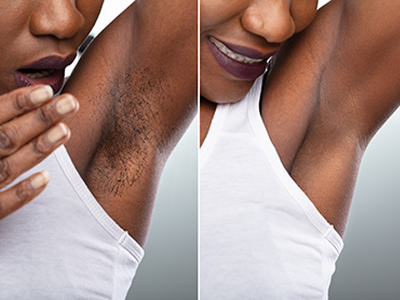
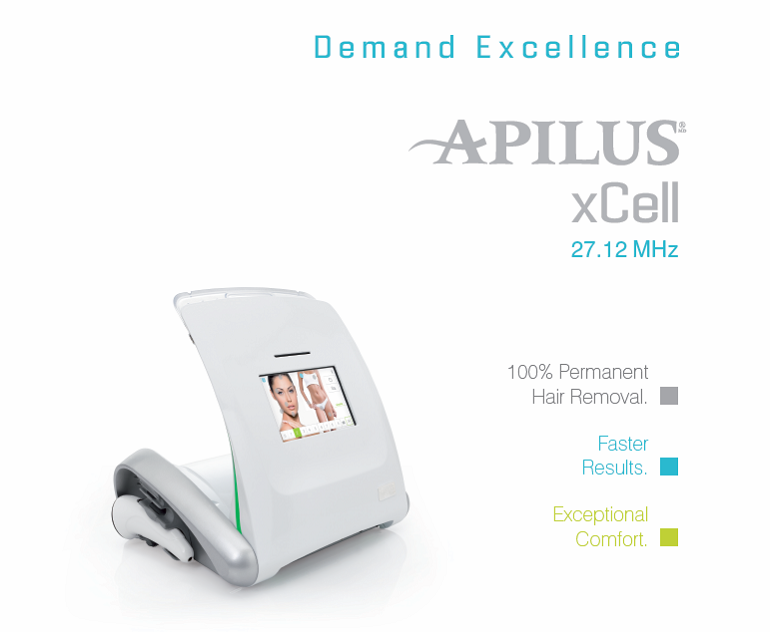

The Gold Standard of Electrolysis Equipment
Apilus xCell sets a new standard in the field of 100% permanent hair removal by raising the efficiency, speed and comfort of its predecessors to a whole new level. Patented and exclusive techniques. Avant-garde design. Intuitive navigation. Sophisticated design with touch screen, personalized treatment programs and the unique 27.12 MHz radio frequency all add up to give you a perfect combination of usability and performance.
Understanding the Hair Growth Cycle
Anagen
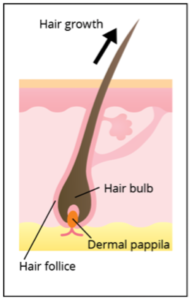
Anagen Phase is the cycle in which the hair begins to grow from the blood supply. The hair will grow deeper and coarser (depending on previous removal methods). This is the phase that electrolysis will permanently destroy the hair follicle and germ cells that create new hairs. It’s important to keep a regular schedule so the electrologist will be able to treat the anagen hairs before they move onto the dormant cycles.
Catogen
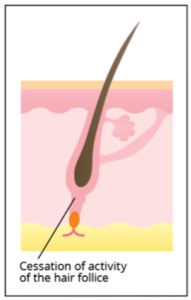
Catagen Phase is when the hair begins to separate from the blood supply and is receiving very little nourishment. In this phase, damage to the follicle can still be accomplished and the hair is likely to grow back less coarse and not as deep. This will in turn make it easier to remove.
Telogen
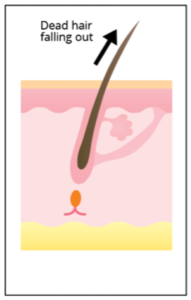
Telogen Phase happens when the hair has separated from the blood supply and is no longer receiving any nourishment. The hair may stay in this phase for a while or it will be shed. There are times a new hair is already growing under the old hair which may cause you to believe that hair regrew quickly. The follicle can be damaged during this stage depending on how long that hair has been dormant.
Frequently Asked Questions
Electrolysis is a generic term that refers to the three methods of permanent hair removal:
- The Thermolysis Method uses high-frequency to produce heat to destroy the hair growth cells.
- The Galvanic Method applies a current which causes the chemistry of the follicle to change thereby destroying the hair producing cells.
- The Blend Method combines both thermolysis and galvanic simultaneously.
Each of these modalities is different but they all achieve the same results – permanent hair removal.
Electrolysis delivers an electrical current to the base of the hair follicle to destroy the blood supply. The FDA considers electrolysis to be permanent hair removal. Electrolysis is great for any color hair and skin tone combination.
Laser delivers light pulses that converts to heat energy to destroy the blood supply. The laser light is attracted to the pigment (melanin) in the hair therefore, one needs to have dark hair for laser to be effective. The FDA considers laser to be permanent reduction therefore reducing hair growth and density up to 85%.
The number of treatments necessary varies for each client. Treatment sessions can range from 15 minutes to more than two hours depending on the area being treated. Factors such as hair growth cycles, the quantity and structure of hair presented, previous use of temporary hair removal methods, heredity, hormone function, certain medications and stress influence the treatment program for each client.
It is very important to adhere to the recommended treatment schedule to achieve optimum results in the shortest time frame. Improvement should be observed within a couple months after initiating treatment, provided the client adheres to the recommended treatment schedule. The client’s role in the treatment process is important to the overall success of treatment. As treatment develops with the decrease of hair growth, sessions will become less frequent and for shorter periods of time until completion.
No. Electrolysis involves labor-intensive, intricate procedures, which require professional judgment and which must be performed in a sanitary environment by a skilled and trained professional.
Factors to consider are:
- The three cycles of hair growth surfacing over a period of a year.
- Previous methods of hair removal like tweezing, waxing, threading or laser, which could affect how long hairs take to resurface and whether the follicle is damaged in such a way as to make electrolysis more difficult. These previous methods could also increase hair growth.
- Medications and hormonal issues.
- Hereditary factors.
**It’s very important to maintain a consistent schedule of appointments.
All hairs have differing cycles of growth and are not visible on the surface of the skin at the same time. Hair normally grows for its usual cycle and then naturally sheds and replaces itself. Following active growing periods (Anagen Phase), most hair follicles go into a dormant stage (Catagen & Telogen Phase). The replacement hairs appear anywhere between 4-10 weeks depending on the location and other growth factors. The appearance of these coarse replacement hairs from dormant hair follicles should not be mistaken as regrowth from previously treated follicles.
Electrolysis works for the largest variety of skin and hair types. It can be applied to African American, Caucasian, Hispanic, Indian, Asian skin (and every skin tone in-between) and can be applied to most facial and body parts, including: Eyebows, Chin, Upper and Lower Lip, Jaw line and sides of the face, Breast, Underarms, Abdomen, Bikini line, Legs and Back, and Intimate Areas. Based on a personal and confidential consultation, our electrologists will design a treatment plan that addresses your specific hair removal needs.
Unwanted hair can be caused by hormonal changes brought on by pregnancy. Some clinics may perform electrolysis on pregnant women, but we advise no and do not treat pregnant women. We suggest you seek the advice of your physician before beginning treatment. Please wait to seek treatment post pregnancy.
Electrolysis can be performed in most moles where States allow it. We may require written approval from your physician.
Most clients find electrolysis to be a comfortable and tolerable experience. With continually advancing technology, equipment and treatment protocols, Electrolysis is more comfortable and effective than ever before.
However, if you ever feel Electrolysis is uncomfortable during the treatment, our electrologists can adjust the level at any time. Your electrologist will work with you to provide the most comfort during your session.
Immediately following treatment, there may be slight redness, which varies with each individual. You may also experience slight swelling, bumps, small scabs or pimples. We will apply soothing lotion, give you the post treatment instructions and reassurance your skin will heal and look better than before.
Electrolysis Pre-Treatment
DRINK WATER. Drink lots of water before, the day of, and the day after your appointment. It is very important to come to your appointment fully hydrated. Hydrated follicles will ensure a more effective treatment because electrolysis works by using the water content in the follicle. Dehydrated follicles are much more difficult to treat.
ARRIVE EARLY. Please arrive 10 minutes before your appointment. All electrolysis appointments are based on time.
We do offer text confirmations for client convenience. However, the client is ultimately responsible for the appointment, whether or not a confirmation is received.
PAIN RELIEVER. Taking a pain reliever thirty minutes before your appointment will make your treatment more comfortable. A topical anesthetic cream such as 4% lidocaine or EMLA (prescription) may also be applied to the area at least one hour prior to your appointment. A thick layer of anesthetic cream, no larger than the size of your palm, should be applied to the treatment area. Cover the treatment area with saran wrap to ensure maximum effectiveness of the product. Anesthetic creams can be found over the counter or by prescription from your health care provider. Please thoroughly clean the area of treatment before applying your numbing cream because it’s not cleaned off before your treatment to provide the maximized numbing effect.
COMFORTABLE CLOTHES. Wear comfortable lose fitting clothes. If getting breast work done, a button-down blouse is appropriate. Proper draping technique is used for client’s personal privacy and comfort.
SHOWER. Please be courteous to your electrologist and arrive showered prior to any electrolysis work. Especially for areas such as genitals and underarms. In such a case your electrologist cannot work, she will kindly ask to reschedule your appointment.
HAIR LENGTH. Please make sure you hair is at LEAST 1/16 of an inch in length so that it can be treated. If hair is too short, it might not be able to be extracted with tweezers.
Also please trim (not shave) the area to be treated day of your appointment if necessary. This can easily be done with a pair of clippers. If you decide to shave the area, be sure to do so a few days prior to your appointment, allowing enough hair growth for the tweezers to grab. Keeping the hair trimmed allows your electrologist easier access to the hair follicle, and making a more precise insertion, therefore, an easier more effective treatment.
AVOID CAFFEINE. Avoid stimulants such as coffee or caffeine sodas the day of your appointment. This could make you more sensitive to pain. Some female clients have reported more sensitivity during their menstrual cycle and should avoid making appointments around that time. The higher your pain tolerance, the more effective your treatment will be. It is best to work as close to your pain threshold as possible for the most effective treatment.
AVOID SUN. Avoid sun exposure 48 hours prior to your treatment. Doing so will dilate your blood vessels and will lengthen your recovery time.
AVOID RETINOIDS. Do not use Retin A, or any topical retinoid for at least 1 week prior to your electrolysis treatment. Accutane should be discontinued for at least 6 months prior to electrolysis. Having electrolysis services done while on retinoids could result in permanent pigment changes and scarring.
Electrolysis Post-Treatment
DO NOT TOUCH. Bacteria is everywhere and on everything, so never touch the treated area unless hands are thoroughly washed. Touching your skin with dirty hands will cause you to break out.
APPLY ALOE VERA GEL. Apply aloe vera gel as recommended to help soothe and restore the skin. This will help your skin stay moisturized and heal faster.
APPLY ANTIBIOTIC CREAM. If needed, apply Bacitracin, Polysporin, Hydrocortisone or any antibiotic cream cream to the treated area the night of your treatment. This can be applied with clean hands or cotton for up to 48 hours following your treatment. These medicines are designed to kill bacteria on your skin and prevent infections from cuts and burns. This will help your skin heal even faster, especially facial areas. Make sure to follow the recommended dosage on the label or ask your pharmacist.
DO NOT SCRATCH. It is normal for your skin to feel itchy a few days following your treatment. This is inflammation and all part of the healing process. Resist the urge to scratch. You will create tiny cuts in the skin and bacteria from your nails will enter theses cuts causing a nasty skin infection. Not to mention, causing more inflammation to the area which means more itching. If you are tempted to scratch, it is advised to take an antihistamine. If your skin is irritated apply a Hydrocortisone cream, Cortisone, Cortaid or anything with 1% hydrocortisone will work. It is anti-inflammatory and will reduce redness, itching and swelling. Make sure to follow the recommended dosage on the label or ask your pharmacist.
DO NOT PICK. Picking at scabs can cause permanent scarring!!! Light scabbing is a natural part of the healing process. Scabs are lymph fluid that has drained from the treated hair follicle and has dried up at the surface. If scabs appear, allow them to fall off on their own. Never pick a scab off, as this could cause scarring. Using an antibiotic cream on the area for a couple days after treatment will likely prevent scabs from forming. Keeping the area moisturized will help prevent scabs from forming.
COLD COMPRESS. Apply a cold compress to reduce inflammation and swelling. Using an Ice pack on the treated area following treatment will reduce selling and inflammation.
If you experience discomfort while your skin is healing, using an Epsom salt compress will help alleviate symptoms. Add one teaspoon of Epsom salt to half a cup of warm water. Mix and apply the mixture with a clean washcloth for ten minutes at a time. This can be repeated until symptoms subside.
STAY OUT OF THE SUN. Immediately after treatment, you must stay out of the sun to prevent abnormal pigmentation. An area that has been treated is extra sensitive to hyperpigmentation. It is also very sensitive to heat. Skin that has been treated by thermolysis is especially at risk because heat was used to release the hair. Exposing treated skin to additional heat will cause treated skin to become sunburned and inflamed. Do not leave the house without using sunblock with a minimum of 30 SPF Broad Spectrum.
AVOID HOT TUBS, SAUNAS, AND POOLS. Avoid hot tubs and saunas in the first 48 hours. Your pores are open and can easily become infected.
DO NOT WORKOUT. Avoid exercising after your electrolysis appointment. Excessive sweating can cause bacteria to enter open follicles causing a minor infection, resulting in a breakout.
NO MAKEUP. Do not apply makeup for at least 24-48 hours after electrolysis. Your pores are open and can easily become infected. It is okay to wear eye makeup, but no foundation or powder. Application brushes and sponges are full of bacteria that will cause you to break out. Be sure to wash your application brushes with a proper antimicrobial cleanser prior to resuming your regular makeup routine 24-48 hours post treatment.
DO NOT SHAVE. Avoid shaving the area for at least 24-48 hours post treatment. This can cause microscopic cuts and scrapes allowing bacteria to enter the follicles causing infection. Shaving can also cause ingrown hairs to form. Let the skin heal prior to shaving.
NO ASTRINGENTS. Avoid any harsh products until skin is fully healed. This includes perfumes, acne medications, astringents or anything with an alcohol base. These products will dry out your skin. Witch hazel is recommended to cleanse the skin and can be used as a toner.
DO NOT TWEEZE OR PLUCK. Tweezing causes trauma inside the follicle, supplying the follicle with a nutritious blood source resulting in deeper, thicker regrowth. Remember, some regrowth is to be expected
KEEP UP WITH A REGULAR TREATMENT SCHEDULE. Keeping on a regular electrolysis maintenance schedule is very important. If you cannot make your scheduled appointment you may clip, shave, or use a depilatory cream such as Nair to remove the hairs. Keep in mind that treating new regrowth as soon as it appears will result in the most effective treatment. Be sure to maintain a regular treatment schedule!
Make An Appointment & Begin Your Journey!
Book your free consultation today with one of our hair removal specialists. You can book online or by phone. We look forward to meeting you!
